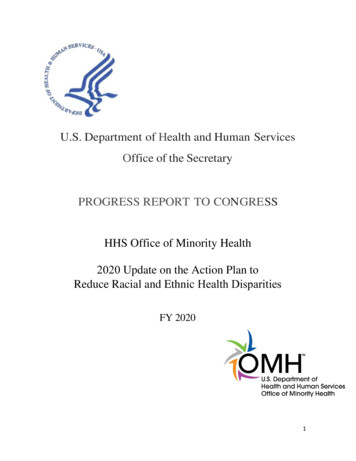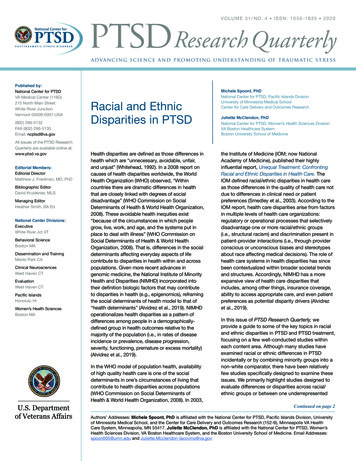Wisconsin's Racial And Ethnic Diversity
Wisconsin'sRacial and EthnicDiversityCensus 2000 Population & PercentagesReport Prepared for:UW-ExtensionWisconsin Associated CountyExtension Committees Annual ConferenceManitowoc, WisconsinJune 24-26, 2001Prepared by:University of Wisconsin Extension& Applied Population LaboratoryAgriculture Hall1450 Linden DriveMadison, WI 53706
EXECUTIVE SUMMARYWisconsin’s Racial Diversity Increasing* While Non-white persons are still a small minority of Wisconsin’s population, Non-whites as apercentage of the state’s total population rose from 7.8% in 1990 to 11.1% in 2000. In 2000, 11 Wisconsin counties had populations that were 10% or more minority. By contrast, onlyfive counties fit this description in 1990. The counties with the five largest minority populations as a percentage of the population are:Menominee (88.4%), Milwaukee (34.4%), Sawyer (18.3%), Racine (17%), and Forest (14.1%). From 1990 to 2000, Non-whites grew from 36.6% to 50% of the population in Milwaukee city.Hispanics or Latinos Are Fastest Growing Racial or Ethnic Group in Wisconsin** From 1990 to 2000, the Hispanic or Latino population in Wisconsin more than doubled (107%increase), the biggest increase of any racial or ethnic group in the state. By contrast, the largest racialgroup in Wisconsin, Whites, increased by only 4.8%. The Hispanic or Latino population in Wisconsin was 3.6% of the states’ total population in 2000,compared to 1.9% in 1990. The Hispanic or Latino population in Wisconsin is concentrated in the Southeastern part of the state.Four counties have more than 10,000 Hispanic or Latino persons: Milwaukee (82,406), Racine(14,900), Dane (14,387), and Kenosha (10,757).Black or African American Persons Increased by Nearly 25% Wisconsin’s Black or African American population increased 24.5% from 1990 to 2000. Blacks orAfrican American persons are the second largest racial group in Wisconsin and are 5.7% of the state’stotal population compared to 5% in 1990. The Black or African American population is mostly concentrated in southeastern and south centralWisconsin. The five counties with the largest Black or African American populations are: Milwaukee(231,157), Racine (19,777), Dane (17,067), Kenosha (7,600), and Rock (7,048). Nearly 76% ofBlack or African American persons in the state reside in Milwaukee County alone. Two counties have Black or African American populations that are more than 10% of thepopulation–Milwaukee (24.6%) and Racine (10.5%).
American Indian and Alaska Native Population Increased by 20% The number of people of American Indian and Alaska Native origin increased 19.9% from 1990 to2000 in Wisconsin. They represent 0.9% of the state’s overall population. The largest populations of American Indian and Alaska Native people are in Milwaukee County(6,794) and Brown County (5,191). From 1990 to 2000, the American Indian and Alaska Nativepopulation fell by 2.9% in Milwaukee County and rose 34.2% in Brown County. When considered as a percentage of the total population, northern Wisconsin counties have thehighest percentages of American Indian and Alaska Native persons. Four counties have populationsthat are more than 10% American Indian and Alaska Native: Menominee (87.3%), Sawyer (16.1%),Forest (11.3%), and Ashland (10.3%).Asian Population Concentrated in Pockets in Southern and Central Portions of the State Asians are the third largest racial group in the state of Wisconsin with 88,763 persons. Theyrepresent 1.7% of the state’s total population. Although the Asian population is numerically greatest in southeastern and south central Wisconsin,there are also relatively large numbers of Asian persons in the central and east central regions of thestate. The counties with the five largest Asian populations are: Milwaukee (24,145), Dane (14,735),Marathon (5,715), Waukesha (5,381), and Brown (4,935). Twenty-seven percent of Wisconsin’s Asian population lives in Milwaukee County. MarathonCounty has the highest percentage of Asians (4.5%).Notes:* Two changes in racial classification for the 2000 Census are especially important to keep in mind when interpretingthis data. In 2000, for the first time, the U.S. Census gave people the option to identify themselves as being of two ormore races (multiracial). Only 1.2% of the state’s population chose this option. To simplify presentation, the racialcategories included in this booklet represent persons who identify themselves as being of a single race. If personsidentifying themselves as multiracial were included, the numbers for each race would be slightly higher. One othersignificant change in the census is that the previous “Asian and Other Pacific Islander” category has been split intotwo separate categories: “Asian” and “Native Hawaiian and Other Pacific Islander.”** It should be noted that in data from the U.S. Census Bureau, Hispanic or Latino is an ethnicity, not a racialcategory. The Hispanic or Latino persons represented in this data can be of any race.
Wisconsin CountiesHispanic or Latino Population, 2000Hispanic or Latino Persons0 - 500500 - 2,5002,500 - 5,0005,000 - 10,000DOUGLASBAYFIELD10,000 - COLNLANGLADETAYLORCHIPPEWASAINT CROIXMENOMINEEDUNNPIERCEMARATHONEAU USHARALA CROSSEWINNEBAGO CALUMETADAMSMONROEJUNEAUNMARQUETTEGREENLAKEFOND DU LACMANITOWOCSHEBOYGANVERNON200RICHLAND20 MilesSAUKCOLUMBIADODGEWASHIN- OZAUKEEGTONCRAWFORDDANEJEFFERSONIOWAWAUKESHA SHAUniversity of Wisconsin Extension & Applied Population LaboratorySource: 2000 Census of Population and HousingU. S. Census Bureau
Wisconsin CountiesHispanic or Latino PopulationChange, 1990 - 2000Change in the Number of Persons-50 - 500500 - 1,0001,000 - 2,500DOUGLAS2,500 - 5,000BAYFIELD5,000 - COLNLANGLADETAYLORCHIPPEWASAINT CROIXMENOMINEEDUNNPIERCEMARATHONEAU USHARALA CROSSEWINNEBAGO CALUMETADAMSMONROEJUNEAUNMARQUETTEGREENLAKEFOND DU LACMANITOWOCSHEBOYGANVERNON200RICHLAND20 MilesSAUKCOLUMBIADODGEWASHIN- OZAUKEEGTONCRAWFORDDANEJEFFERSONIOWAWAUKESHA SHAUniversity of Wisconsin Extension & Applied Population LaboratorySource: 2000 Census of Population and HousingU. S. Census Bureau
Hispanic or Latino Population, 1990 and 2000:Top 20 Wisconsin Counties*Hispanic or Latino ckSheboyganOutagamieWinnebagoJeffersonDodgeFond Du LacWashingtonManitowocOzaukeeLa 3990979967% 25%168%161%140%112%128%131%107%55%108%69%* Ranking based on 2000 Census figuresSources: 1990 Census of Population and Housing, 2000 Census of Population and Housing; U.S. Census BureauPercent of Total Population Hispanic or Latino, 2000:Top 20 Wisconsin CountiesHispanic or Latino eGreen LakeFond Du 883931,9873,2073,065357740% of .7%2.6%2.5%2.1%2.0%2.0%2.0%1.9%1.8%Sources: 1990 Census of Population and Housing, 2000 Census of Population and Housing; U.S. Census Bureau.
Increase in Hispanic or Latino Population, 1990-2000:Top 20 Wisconsin CountiesHispanic or Latino 53167421120327% rce: 1990 Census of Population and Housing, 2000 Census of Population and Housing; U.S. Census Bureau.
Wisconsin CountiesRacial & Ethnic Diversity, Census 2000HISPANICWHITEMaximum: Lafayette (99.0%)Maximum: Milwaukee (8.8%)Percent of County Total Population0.0% - 1.0%1.1% - 2.0%2.1% - 5.0%5.1% - 10.0%10.0% - 100.0%BLACK OR AFRICAN AMERICANMaximum: Milwaukee (24.6%)NATIVE AMERICAN OR ALASKA NATIVEMaximum: Menominee (87.3%)University of Wisconsin Extension & Applied Population LaboratorySource: 2000 Census of Population and HousingU.S. Census Bureau
Wisconsin CountiesRacial & Ethnic Diversity, Census 2000ASIANNATIVE HAWAIIAN 0R OTHER PACIFIC ISL.Maximum: Marathon (4.5%)Maximum: Marquette (0.1%)Percent of County Total Population0.0% - 1.0%1.1% - 2.0%2.1% - 5.0%5.1% - 10.0%10.0% - 100.0%OTHER RACEMULTIRACIALMaximum: Milwaukee (4.2%)Maximum: Milwaukee (2.2%)University of Wisconsin Extension & Applied Population LaboratorySource: 2000 Census of Population and HousingU.S. Census Bureau
Racial and Ethnic Diversity of Wisconsin County Populations, DoorDouglasDunnEau ClaireFlorenceFond du LacForestGrantGreenGreen a RichlandRockRuskSt. WausharaWinnebagoWoodWisconsinRace and Ethnicity (in %)Persons Who Reported One RaceNativeAmerican IndianHawaiian andBlack or Africanand AlaskaOther %Source: 2000 Census of Population and Housing, U.S. Census Bureau.Some OtherRaceMultiracialHispanic(of all 2.0%0.9%0.0%1.6%1.2%3.6%
8,42638,22035,77535,476TotalPopulationSource: 2000 Census of Population and Housing, U.S. Census Bureau.Milwaukee (city)Madison (city)Green Bay (city)Kenosha (city)Racine (city)Appleton (city)Waukesha (city)Oshkosh (city)Eau Claire (city)West Allis (city)Janesville (city)La Crosse (city)Sheboygan (city)Wauwatosa (city)Fond du Lac (city)Brookfield (city)Wausau (city)New Berlin (city)Beloit (city)Greenfield 0.0%0.0%0.0%0.1%0.0%0.0%0.0%0.0%0.1%0.0%Race and Ethnicity (in %)Persons Who Reported One RaceNativeHawaiian andAmerican IndianOther Pacificand AlaskaBlack or 3%0.5%4.6%1.3%Some OtherRaceRacial and Ethnic Diversity of 20 Largest Wisconsin Places, 3%1.7%1.2%1.2%0.8%1.2%0.7%2.8%1.3%Two 6%1.1%6.0%1.7%2.9%1.2%1.0%1.6%9.1%3.9%Hispanic(of all races)
Hispanics or Latinos Are Fastest Growing Racial or Ethnic Group in Wisconsin** From 1990 to 2000, the Hispanic or Latino population in Wisconsin more than doubled (107% increase), the biggest increase of any racial or ethnic group in the state. By contrast, the largest racial group in Wisconsin, Whites, increased by only 4.8%.
racial/ethnic minority investigators and research participants. The presence of more minority group investigators would encourage more racial/ethnic minority individuals to participate in research. Moreover, both empirical and anecdotal evidence reveals that racial/ethnic minority investigators often have a particular commitment to research
Racial and ethnic minorities are at greater risk for exposure to and adverse outcomes from COVID-19 due to social determinants of health and living and working conditions. A greater prevalence of underlying health conditions also put racial and ethnic minorities at higher risk for severe illness and death from COVID-19.
racial/ethnic minority group and a White group comparator. Research to assess and evaluate potential racial and ethnic . disparities requires specific sampling, assessment, covariate selection, and statistical modeling approaches and we provide some references for those interested in learning more.
Apr 07, 2017 · The US Department of Health and Human Services ’ Administration for Children and Families (ACF) is interested in investigating how existing work on racial and ethnic disparities could inform more accurate identification and interpretation of ethnic and racial differences in programs administered by
8 Interventions to Improve Minority Health Care and Reduce Racial and Ethnic Disparities Evidence-based Synthesis Program EVIDENCE REPORT INTRODUCTION BACKGROUND Racial and ethnic disparities are widespread in the US health care system.
Racial and Ethnic Disparities by Gender in Health Care in Medicare Advantage Patterns of racial and ethnic differences in patient experience among women and among men parallel the differences that were observed among both groups combined (see figure on p. xii). Among both
Racial/ethnic minority groups have greater percentages of people younger than 25 years (.0 percent) when compared 44 with White nonHispanics- (24.9 percent). In contrast, people aged 65 years and older accounted for (24.3 percent) of White non-Hispanics, but only (7.4 percent) of all racial/ethnic minority groups combined.
The Project Gutenberg EBook of First Course in the Theory of Equations, by Leonard Eugene Dickson This eBook is for the use of anyone anywhere at no cost and with almost no restrictions whatsoever. You may copy it, give it away or re-use it under the terms of the Project Gutenberg License included with this eBook or online at www.gutenberg.org Title: First Course in the Theory of Equations .























